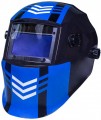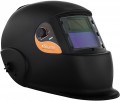Min. degree of darkening
The smallest degree of obscuration provided by the chameleon mask (see "Type") when the light filter is activated. Recall that dimming is indicated in DIN units, the larger the number in this paragraph, the darker the filter.
This parameter is indicated only for models with dimming control (see "Functions"). From the minimum degree of dimming depends on the extent to which you can adjust the light transmission. At the same time, we recall that a darker light filter protects better from bright light, but worsens visibility; so for some tasks, a relatively low level of obscuration may be optimal. Accordingly, the lower this indicator, the wider the adjustment range of the filter, the more opportunities the user has to adjust it (with the same maximum threshold). On the other hand, the expansion of the adjustment range significantly affects the cost, and such characteristics are not always required. Therefore, nowadays, you can find chameleon masks both with a small (
5 DIN and even
less), and with a fairly significant minimum dimming (
7 DIN or even
9 DIN). And it’s worth choosing here, depending on what is more important for you: an extensive range of adjustment or low cost.
Filter viewing area (WxH)
The size of the transparent part of the light filter — the "working window", the area through which the welder sees the place of work. A larger working window provides ease of use and a wide field of view, but it significantly affects the cost of the mask and somewhat reduces the strength of the light filter.
Optical sensors
Optical sensors determine the filter response speed. They respond to sudden changes in lighting and arc flicker — characteristic signs of the start of welding work. The more sensors in the mask design, the less likely the filter will open during welding. To better capture the difference in radiation, sensors are often placed at different corners of the mask.
Operating temperature
The range of ambient air temperatures at which the mask is guaranteed to be able to function normally. This parameter is especially important for "chameleons" (see "Functions"), because. the performance of the automatic filter directly depends on external conditions (in particular, at low temperatures, the response time may increase).
Delay time adjustment
The ability to manually set the delay time between the disappearance of the arc and turning off the filter in the chameleon mask. Such a delay is highly desirable in the light of the fact that even after the arc is turned off, the heated metal continues to glow for some time; therefore, it is advisable not to turn off the filter immediately.
Adjusting the delay time allows the welder to independently choose the time to return to the non-working (maximally transparent) state.
Grinding mode
A special mode of operation of the chameleon mask, in which the light filter sensors are completely turned off — thus, it constantly remains transparent and does not respond to any flashes. This mode is useful for jobs that can produce fairly bright flashes of light, but do not require dimming. A classic example of such work is grinding with a “grinder” or a machine tool, when sparks can fly from the workpiece; hence the name of this function —
"grinding" mode.
Design features
— Backlight. Illumination system built right into the mask. This feature is very convenient when working in low light conditions: the backlight does not take up the hands (unlike hand-held flashlights) and does not create problems with wearing a mask (unlike headlamps), while the beam of light is always directed to where the welder's head is turned. On the other hand, such a system requires its own power supply. Therefore, it is used only in "chameleons", while the operation of the backlight additionally consumes battery power.

